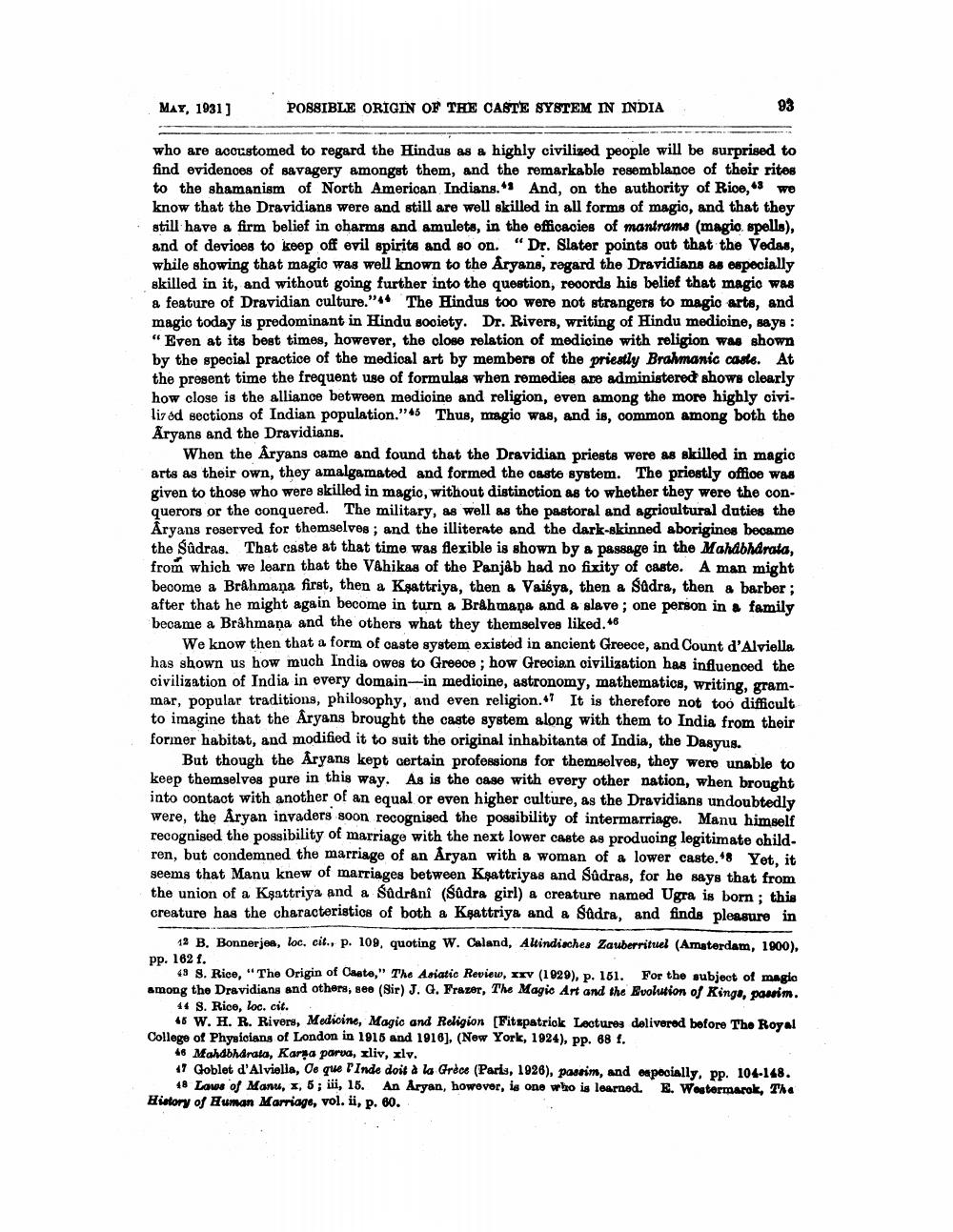________________
MAY, 1931)
POSSIBLE ORIGIN OF THE CASTE SYSTEM IN INDIA
who are acoustomed to regard the Hindus as a highly civilized people will be surprised to find evidences of savagery amongst them, and the remarkable resemblance of their rites to the shamanism of North American Indians." And, on the authority of Rice, we know that the Dravidians were and still are well skilled in all forms of magio, and that they still have a firm belief in charms and amulete, in the efficacies of mantrams (magio, spells), and of devices to keep off evil spirits and so on. “ Dr. Slater points out that the Vedas, while showing that magio was well known to the Aryans, regard the Dravidians as especially skilled in it, and without going further into the question, records his belief that magic was a feature of Dravidian culture." * The Hindus too were not strangers to magio arts, and magic today is predominant in Hindu society. Dr. Rivers, writing of Hindu medicine, says: "Even at its best times, however, the close relation of medicine with religion was shown by the special practice of the medical art by members of the priestly Bralvmanic caste. At the present time the frequent use of formulas when remedies are administered shows clearly how close is the alliance between medioine and religion, even among the more highly civi. lized sections of Indian population."15 Thus, nagio was, and is, common among both the Aryans and the Dravidians.
When the Aryans came and found that the Dravidian priests were as skilled in magic arts as their own, they amalgamated and formed the caste system. The priestly office was given to those who were skilled in magic, without distinction as to whether they were the conquerors or the conquered. The military, as well as the pastoral and agricultural duties the Aryans reserved for themselves; and the illiterate and the dark-skinned aborigines became the Sadrag. That caste at that time was flexible is shown by a passage in the Mahabharata, from which we learn that the Vahikas of the Panjab had no fixity of caste. A man might become a Brahmana first, then a Kşattriya, then a Vaibya, then a Sadra, then a barber; after that he might again become in turn a Brahmaņa and a slave; one person in a family became a Brahmana and the others what they themselves liked. 46
We know then that a form of oaste system existed in ancient Greece, and Count d'Alviella has shown us how much India owes to Greece, how Grecien civilization has influenced the civilization of India in every domain-in medicine, astronomy, mathematics, writing, grammar, popular traditions, philosophy, and even religion. It is therefore not too difficult to imagine that the Aryans brought the caste system along with them to India from their former habitat, and modified it to suit the original inhabitants of India, the Dasyus.
But though the Aryans kept certain professions for themselves, they were unable to keep themselves pure in this way. As is the case with every other nation, when brought into contact with another of an equal or even higher culture, as the Dravidians undoubtedly were, the Aryan invaders soon recognised the possibility of intermarriage. Manu himself recognised the possibility of marriage with the next lower caste as produoing legitimate children, but condemned the marriage of an Aryan with a woman of a lower caste. 8 Yet, it seems that Manu knew of marriages between Kşattriyas and Sudras, for he says that from the union of a Kşattriya and a Sadrani (Sudra girl) a creature named Ugra is born; this creature has the characteristics of both a Kşattriya and a Sudra, and finds pleasure in
12 B. Bonnerjen, loc. cit., p. 109, quoting W. Caland, Altindisches Zauberrituel (Amsterdam, 1900),
pp. 162 1.
48 . Rice, "The Origin of Caste," The Asiatic Review, XIV (1029), p. 151. For the subject of maglo among the Dravidians and others, 800 (Sir) J. G. Frazer, The Magio Art and the Evolution of Kingo, passim.
44 S. Rice, loc. cit.
45 W. H. R. Rivers, Medicine, Magio and Religion (Fitspatriok Lectures delivered before The Royal College of Physicians of London in 1915 and 1916), (New York, 1924), pp. 68 f.
46 Mahdbharala, Karsa parua, zliv, xly. 11 Goblet d'Alviella, Oe que 'Inde doit à la Grèce (Paris, 1926), passim, and especially. pp. 104-148.
49 Laws of Manu, X, 5; iii, 15. An Aryan, however, is one who is learned. E. Westermarok, Tha History of Human Marriage, vol. ii, p. 60.




